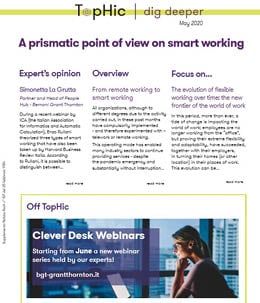All organizations, although to different degrees due to the activity carried out, in these past months have compulsorily implemented - and therefore experimented with – telework or remote working. This operating mode has enabled many industry sectors to continue providing services - despite the pandemic emergency and substantially without interruption - preserving the health of employees, freelancers, collaborators, etc., as well as the existence of the companies themselves, allowing businesses to contain the risk of economic damages that would be difficult to reverse. Firstly, while approaching the subject in point, it is necessary to clarify the terminology.
Very often, lately, in order to define the work activity carried out in one’s own home, people have been using without distinction the term smart working, which, is indeed a method reserved only for employees, regulated under the Law no. 81/2017 and is an evolution of the concept of telework/remote working.
According to the definition formulated by Professor Mariano Corso, scientific director of the Smart Working Observatory of the Politecnico University in Milan, “Smart Working, or Agile Work, is a new managerial philosophy based on giving people flexibility and autonomy in choosing spaces, timetables and tools to be used in the face of greater responsibility for results.
A new approach to the way of working and collaborating within a company that is based on four main pillars: revision of the organizational culture, flexibility with respect to working hours and workplaces, technological equipment and physical spaces”. Smart working is, therefore, “intelligent autonomous employment by objectives”, already implemented and running for a long time in sectors such as software development, high tech, fintech and in activities that constantly interact globally1. Remote working, on the other hand, is similar to telework i.e. the delocalisation of work.
Again, in many ways we can say that we could define, more correctly, the phenomenon we are witnessing in this period, as emergency working2, as it is essentially a “unstructured” telework, not being organised and not being part of a medium-long term company strategy. Beyond the terminology, this operating mode has brought undoubted benefits, allowing us to gain a more widespread understanding of the advantages in terms of efficiency and effectiveness that can derive from it.
It has also allowed us to assess how the limits this working modality implies are in part non-existing and largely surmountable (we refer mainly to the employee’s absence from the place where the economic activity of the organization he/she belongs to is traditionally carried out). There is already a strong trend, at least in the intentions, to implement - once the emergency phase will be over - new organizational models that can get closer to actual smart working models, supported by comprehensive regulatory provisions, aligned with the transformed operating framework.

